#Taschenberg
Explore tagged Tumblr posts
Text

Ruins of Taschenberg Palace and Dresden Castle (Residenzschloss), Dresden, 1982. From the Budapest Municipal Photography Company archive.
139 notes
·
View notes
Text
A Walk Around Old Town & Catching Up With A Friend - Dresden, Germany
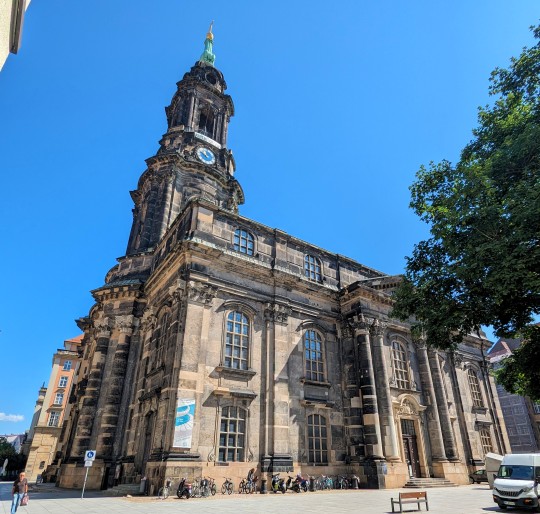
Today was a very full day. We started with a walk around Dresden, checking out some places we missed yesterday. First stop, was the Church of the Holy Cross (pictured above) and then on to the Rathaus (pictured below).


We continued to wander around checking out some of the other buildings in Old Town. Domes in the distance in this picture, but we didn’t figure out what they belonged to.

Theater Building.

Statue in Bruhlsche Garten.
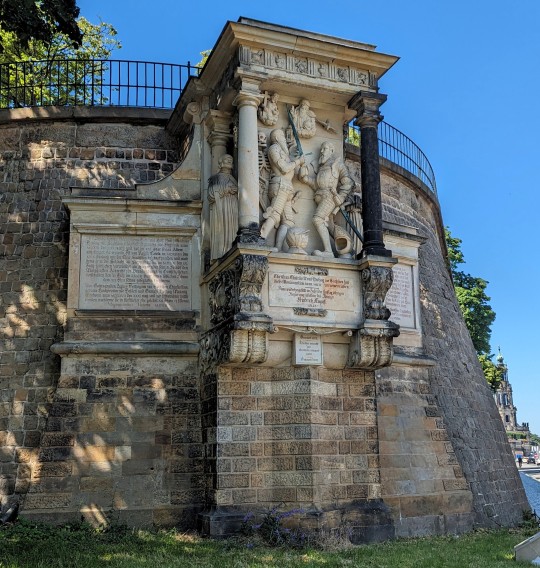
Moritz Monument built on the outside wall of the Bruhl Terrace, it is one of the oldest preserved structures in Dresden.

Along the Bruhl Terrace Wall, looking for the historic city gates. Which we found, in the pictures below, but they didn’t really impress us and were hard to check out due to fear of being run over!




Another view of Kathedrale Sanctissimae.

Residenzschloss and the Bridge over Taschenberg Street.
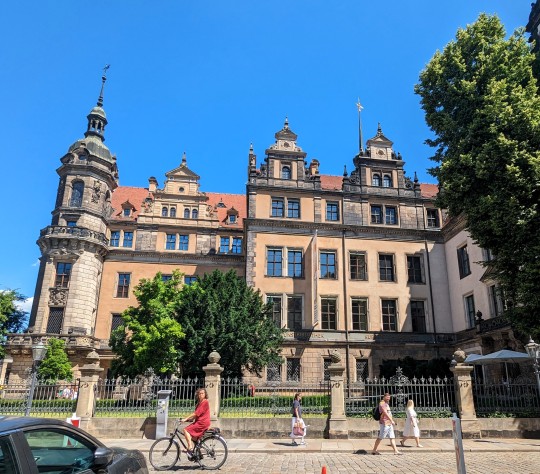
Residenzschloss.
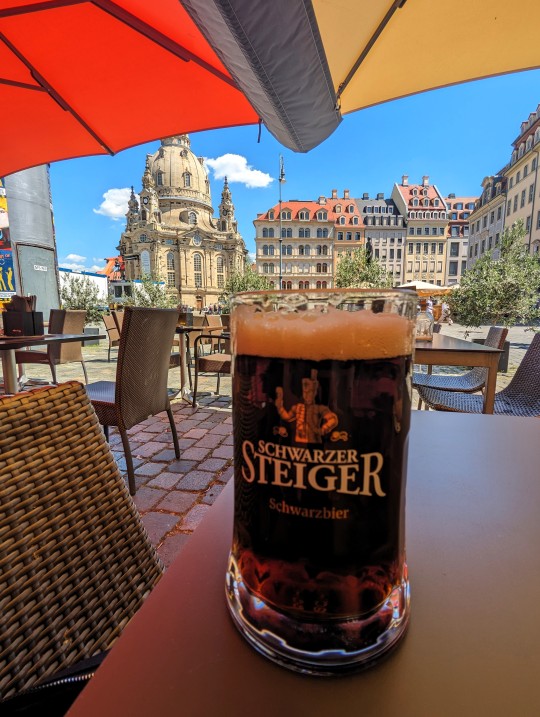
Lunch on the plaza, before we headed back to our place to rest up for this evening’s activities.
A few years ago, when we were staying in a free campsite just outside of Bryce Canyon NP with our friends, John and Charmaine, we met up with a guy from Paris, France who was bicycling around the world. His name was Nico, and he spent a couple of days with us. We have kept in touch with him on and off over the years, he is now living in Dresden. We are meeting him and his family this evening. We walked about 45 minutes to meet him at a designated location (we really don’t mind walking). From there, we walked a short distance to a beautiful park and met his beautiful family - his wife, Sabine, his son, Lucas, and his daughter, Sophie. We hung out with them for a couple of hours - visiting a beer garden for dinner and then walking back to their place to enjoy a bottle of wine from his wine cellar. What a lovely evening!

Doug, getting to know Sophie.
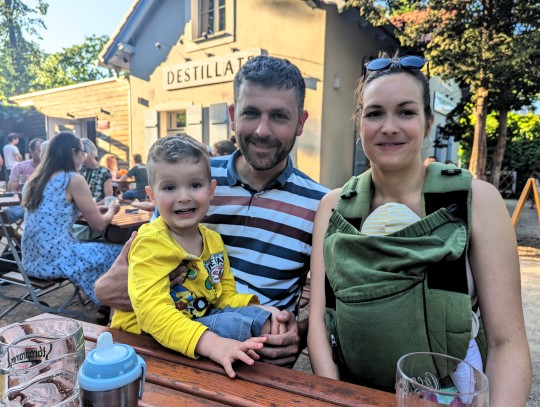
Lucas, Nicolai (Nico), Sabine, and Sophie.

A cool historical plaque near their home.
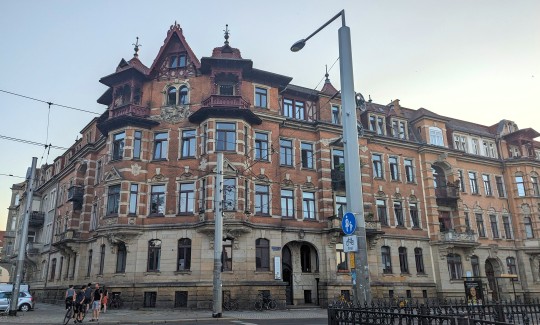
The building that their home is in - quite a gorgeous structure.

Nico’s impressive wine cellar!
0 notes
Text
Aufgeschlossen! Vom ersten Kunstkämmerer zur Online Collection: Dresden bis 25. 09. 2022
Aufgeschlossen! Vom ersten Kunstkämmerer zur Online Collection: Dresden bis 25. 09. 2022
Schlüssel sind hochsymbolische Objekte. Sie spielen eine wichtige Rolle in der Magie, Volksfrömmigkeit und im höfischen Zeremoniell. So erhielten Kammerherren am Dresdner Hof der Barockzeit einen vergoldeten Schlüssel als Würdezeichen. Schlüssel haben aber auch einen ganz praktischen Nutzen: Nicht nur zum Auf- und Zuschließen von Räumen, Truhen, Schränken und Behältnissen aller Art, sondern auch…

View On WordPress
#Aufgeschlossen#Bartholomäus Hoppert#David Uslaub#Dresden#Dresdner Schatzkammer#Kunstkämmerer#Kurfürst August von Sachsen#Neues Grünes Gewölbe#Schlüssel#Schlüsselgeschichte#Sponsel-Raum#Staatliche Kunstsammlungen Dresden#Taschenberg#Tilman Hornig#Volksfrömmigkeit#Würdezeichen#Zeremoniell
0 notes
Text
Kontaktaufruf von Party
Das Gesundheitsamt des Landkreises Nordhausen startet einen Kontaktaufruf im Zusammenhang mit einer 3G-Plus-Party im Club T37 in Nordhausen. Bei einem Gast der Veranstaltung am Samstag, 6. November, wurde der Corona-Erreger nachgewiesen, der Laborbefund lag gestern vor. Aufgrund der Vielzahl der Gäste bittet das Gesundheitsamt alle Besucher mit Test, die sich zwischen 21:45 und 23:30 Uhr im Club…

View On WordPress
#Corona#Event#Gesundheitsamt#Infos#Kontaktaufruf#Kontakte#Nachverfolgung#Nordhausen#Party#T37#Taschenberg
1 note
·
View note
Photo










Staff Pick of the Week
This week’s staff pick is part 4, volume 1 of Brehms Thierleben, published in Leipzig in 1884. This volume is on insects, and features work by German entomologist Ernst Ludwig Taschenberg. Brehms Thierleben is a multivolume zoological encyclopedia by Alfred Edmund Brehm that was first published under the title Illustrirtes Thierleben from 1864-1869. A second edition with the new title Brehms Thierleben was published as a ten volume set from 1876 to 1879, and was later reprinted from 1882 to 1884.
I chose this book because of the gorgeous chromolithograph illustrations of insect life. Lately, my love of bugs has reached an all-time high. I think they are fascinating, alien-like creatures. While I would not want to stumble across the Goliath bird-eating spider in real life, I enjoy looking at pictures of them. Some other insects that I’ve chosen to highlight are the Hercules beetle, lanternflies (not to be confused with fireflies), and silk moths.
It also happens to be National Insect Week in the UK. I have not found anything similar here in the United States, but maybe someone should start it?
View more posts about Brehms Thierleben.
–Sarah, Special Collections Graduate Intern
#Brehms Thierleben#Alfred Edmund Brehm#Ernst Ludwig Taschenberg#insects#bugs#chromolithographs#Yay chromoliths!#staff pick of the week#national insect week#sarah
73 notes
·
View notes
Photo

Two ants and a beetle appear to be engaged in some kind of heist on the right side of this elaborate illustration from Ernst Ludwig Taschenberg’s Was da kriecht und fliegt (1878).
Full text here.
207 notes
·
View notes
Text
Today's Flickr photo with the most hits; the Schloss Taschenberger bridge, Altstadt, Dresden.
3 notes
·
View notes
Photo

Beetles illustration
from Brehm, Alfred Edmund and Ernst Ludwig Taschenberg. Die Insekten, Tausendfüssler und Spinnen. 1884.
Contributed in BHL from Albert R. Mann Library at Cornell University.
74 notes
·
View notes
Photo

Part 4, volume 1 of “Brehms Thierleben”, published in Leipzig in 1884.
This volume is on insects, and features work by German entomologist Ernst Ludwig Taschenberg.
#book#spider#wound and pain and death#bird#arthropod#art#scientific illustration#beautiful flower#moth and butterfly#science#animal
26 notes
·
View notes
Photo




0 notes
Text
Introduction to Spider Wasp
A. asiaticus of spider wasp
A. asiaticus may refer to:
An abbreviation of a species name. In binomial nomenclature the name of a species is always the name of the genus to which the species belongs, followed by the species name (also called the species epithet). In A. asiaticus the genus name has been abbreviated to A. and the species has been spelled out in full. In a document that uses this abbreviation it should always be clear from the context which genus name has been abbreviated.
Some of the most common uses of A. asiaticus are:
Acartauchenius asiaticus, a money spider species in the genus Acartauchenius
Aduncothrips asiaticus, a thrip species in the genus Aduncothrips
Aesalus asiaticus, a beetle species in the genus Aesalus
Alastor asiaticus, a wasp species in the genus Alastor
Araneus asiaticus, an orb-weaver spider species
Archaeornithomimus asiaticus, a dinosaur species
Asiabadus asiaticus, a ground spider species in the genus Asiabadus
Asprella asiaticus, a snail species in the genus Asprella
------
Mesosoma of spider wasp
The mesosoma is the middle part of the body, or tagma, of arthropods whose body is composed of three parts, the other two being the prosoma and the metasoma. It bears the legs, and, in the case of winged insects, the wings.
In hymenopterans of the suborder Apocrita (wasps, bees and ants), it consists of the three thoracic segments and the first abdominal segment (the propodeum). For historical reasons, in ants it is commonly referred to by the alternative name alitrunk.
In scorpions, it is composed of six segments and forms the first part of the abdomen, containing all of the major organs. The first segment contains the sexual organs as well as a pair of vestigial and modified appendages forming a structure called the genital operculum. The second segment bears a pair of featherlike sensory organs known as the pectines; the final four segments each contain a pair of book lungs. The mesosoma is armoured with chitinous plates, on the upper surface by the tergites and on the lower surface by the sternites.
In other arachnids such as spiders, the mesosoma is fused with the metasoma to form the opisthosoma.

------
Selected species of spider wasp
Agenioideus acconeus (Banks, 1947)
Agenioideus apicalis (Vander Linden, 1827)
Agenioideus arenicolus (Priesner, 1955)
Agenioideus biedermani (Banks, 1910)
Agenioideus birkmanni (Banks, 1910)
Agenioideus ciliatus (Lepeletier, 1845)
Agenioideus cinctellus (Spinola, 1808)
Agenioideus coronatus (Nouvel & Ribaut, 1958)
Agenioideus dichrous (Brulle, 1840)
Agenioideus excisus (Morawitz, 1890)
Agenioideus expulsus Turner 1917
Agenioideus fascinubecula Wolf, 1986
Agenioideus fertoni (Saunders, 1901)
Agenioideus gentilis (Klug, 1834)
Agenioideus humilis (Cresson, 1867)
Agenioideus injudicatus Junco y Reyes, 1960
Agenioideus ishikawai Shimizu, 1989
Agenioideus kerkyrus Wolf, 1985
Agenioideus kokya Shimizu & Wahis, 2009
Agenioideus maculipes (Smith, 1870)
Agenioideus minutus (Banks, 1947)
Agenioideus nigricornis (Fabricius), 1775
Agenioideus nubecula (Costa, 1874)
Agenioideus poultoni (Saunders, 1904)
Agenioideus rhodosoma (Kohl, 1886)
Agenioideus ruficeps (Eversmann, 1849)
Agenioideus rytiphorus (Kohl, 1886)
Agenioideus seminiger (Taschenberg, 1880)
Agenioideus sericeus (Vander Linden, 1827)
Agenioideus tussaci Wolf, 1986
Agenioideus usurarius (Tournier, 1889)
------
Wytham Woods of spider wasp
Wytham Woods is a 423.8-hectare (1,047-acre) biological Site of Special Scientific Interest north-west of Oxford in Oxfordshire. It is a Nature Conservation Review site.
Habitats in this site, which formerly belonged to Abingdon Abbey, include ancient woodland and limestone grassland. Over 500 species of vascular plant have been recorded, and more data about the bird, mammal and invertebrate fauna, have probably been recorded about this site than any other in the country as a result of studies by Oxford University. More than 900 species of beetles, 580 of flies, 200 of spiders, 700 of bees, wasps and ant, 250 of true bugs and 27 of earthworms have been recorded.
Access is only allowed with a permit from the owner, Oxford University.
------
Irenangelus of spider wasp
Ireangelus is a genus of kleptoparasitic spider wasps from the sub-family Ceropalinae of the family Pompilidae. The genus has a pan tropical distribution,being known from Oriental, Neotropical, Australian, eastern Palearctic, and Madagascan Zoogeographic regions being best represented in the Neotropics. Irenangelus is closely related to the more widespread genus Ceropales, the two genera forming a monophyletic subfamily, Ceropalinae within the Pompilidae. This is regarded as the most basal grouping of the Pompilidae but this view is problematic because of the kleptoparasitic life history of the Ceropalines, it is now considered that they Ceropalines and other pompilids evolved from a common ectoparasitoid ancestor.
------
Priocnemis perturbator of spider wasp
Priocnemis perturbator is a relatively large species of spider wasp which is quite common in Europe. It was previously considered to be the same species as the closely related P. susterai which were lumped as P. fuscus and this means that some early observations of behaviour are not applicable to either species. Even now the two species need close observation under a microscope or hand lens to distinguish them from each other.

------
Nigricauda of spider wasp
Nigricauda, a Latin word meaning black-tailed, may refer to:
B. nigricauda
Brycinus nigricauda, Thys van den Audenaerde, 1974, a ray-finned fish species in the genus Brycinus
D. nigricauda
Dasymutilla nigricauda, a wasp species in the genus Dasymutilla
E. nigricauda
Enneapterygius nigricauda, Fricke, 1997, the blacktail triplefin, a fish species in the genus Enneapterygius
N. nigricauda
Nephrotoma nigricauda, Alexander, 1925, a species in the genus ''Nephrotoma
R. nigricauda
Rineloricaria nigricauda, a freshwater tropical catfish species in the genus Rineloricaria
------
Behavior of spider wasp
Megarhyssa nortoni is a predatory insect. Its larvae are parasitoids of horntail wasp larvae in coniferous trees. The adult female hunts horntail larvae for egg placement. It smells wood-eating fungus, utilized by the horntail larvae to predigest wood pulp, and uses its antennae to detect vibrations made by the horntail larvae. The female M. nortoni curls its ovipositor over its abdomen to insert the tip of the ovipositor at a right angle into the bark and cuts into the tree until it reaches the horntail larval tunnel. The female then deposits a very slender egg through its ovipositor into the tunnel on or near the horntail larva. The M. nortoni larva then hatches to eat the live horntail larval host from the inside causing the horntail larva's eventual death. The M. nortoni larva pupates inside its host and emerges the following summer as an adult.
Although imposing, the female M. nortoni does not sting and is harmless to humans. Adult M. nortoni feed on nectar and water.
------
Dipogon of spider wasp
Dipogon is a genus of spider wasps of the family Pompilidae in the subfamily Pepsinae. They are found in Europe, Asia, and North America. Their generic name ("two beards") comes from the characteristic long bristle tufts just below the mandibles, which are used to carry material to construct the cells in the nest, and for constructing the nest.
Species in Dipogon include:
------
Homonotus of spider wasp
Homonotus is a genus of spider hunting wasps with an old world distribution, mainly in Africa.
Species in the genus include
Homonotus aegyptiacus Turner, 1917
Homonotus coxalis Dahlbom, 1843
Homonotus disparilis Turner, 1917
Homonotus dispersus Dahlbom, 1843
Homonotus dissectus Dahlbom, 1843
Homonotus formosanus Yasumatsu 1933
Homonotus fuscipes Dahlbom, 1843
Homonotus imitans Dahlbom, 1843
Homonotus iwatai Yasumatsu 1932
Homonotus leptogaster Dahlbom, 1843
Homonotus okinawanus Tsuneki 1990
Homonotus ruficornis Cameron, 1905
Homonotus rukwaensis Arnold, 1946
Homonotus sanguinolentus (Fabricius, 1793)
Homonotus sansibaricus Dahlbom, 1843
Homonotus semiflavus Priesner 1955
Homonotus tagalicus Banks 1934
Homonotus taiwanus Tsuneki 1990
------
Tastiotenia festiva of spider wasp
Tastiotenia festiva is a species of spider wasp in the subfamily Pompilinae. It was first described by its discoverer, Howard Ensign Evans, in 1950. It is a rather small spider wasp species, growing from 36.
5 mm in length and has only been observed rarely. It lives in the desert regions of the south-western United States (southern California to western Texas) as well as northern Mexico (Sonora and Baja California). Based on Evans' biological observation in 1961, it is assumed that Tastiotenia festiva consumes black widow spiders as part of its diet and that it utilizes burrows made by other wasps for nesting.
------
Thalassianthus aster of spider wasp
Thalassianthus aster is a species of sea anemone in the family Thalassianthidae. It dwells in a number of habitats, even existing symbiotically on top of other motile invertebrates such as hermit crabs in a relationship similar to the pom pom crab. Its nematocysts contain a Type-II Na-channel toxin known as -TLTX-Ta1a according to the currently developing systematic nomenclature for peptide and protein toxins from sea anemones.
On a hermit crab
Red color morph
Stinging nematocysts
------
Biota of spider wasp
It seems no detailed survey has been done of the lake. As cattle often walk in the lake it is likely to be polluted. In the 1970s the dunes between the lake and the harbour were sown with tree lupin (Lupinus arboreus) and Marram Grass, which has reduced sand movement and provided a low quality pasture. Frogs can be heard croaking in the lake. The pompilid wasp (Cryptocheilus australis) and its prey, the nursery web spider (Dolomedes minor), have been seen near the lake
------
Biology of spider wasp
Adults of T. unicolor feed at honeydew secretions and flowers. Females have been captured at honeydew from galls of Disholcapsis eldoradensis on Quercus lobata and at flowers of Asclepias erosa, Baccharis sarothroides, Chrysothamnus sp., Lepidospartum squamatum, and Wislizenia refracta. Males have been taken on the flowers of Calochortus catalinae, Hemizonia fasciculata, Rhamnus californica, and Xanthium spinosum. Both males and females visit the extrafloral nectaries of Helianthus and have been collected at flowers of Atriplex semibaccata, Cicuta sp., Eriogonum fasciculatum, Eriogonum gracile, and Foeniculum vulgare. The flight period in California is from May to October, with a peak in July and August.
------
Anatrachyntis terminella of spider wasp
Anatrachyntis terminella is a moth in the family Cosmopterigidae. It was described by Francis Walker in 1864 and is known from Australia (including New South Wales) and Fiji.
The wingspan is about 8mm. The forewings are patterned and hindwings have trailing hairy fringes.
The larvae have been recorded in deserted nests of wasps of the genus Polistes, galls on flower buds of Acacia binervata, egg sacs of the spider Trichonephila edulis as well as dead insects and dead leaves.
------
Geology of spider wasp
Brown clay underlies the dunes, which limits the rate of seepage through the dunes, thus forming lakes where dune advance has blocked valleys. The lake bed and stream are on Awhitu sands. They are about a million years old and made up of pumiceous cross bedded brown and yellow clayey sands. The lake is dammed by dunes of Nukumiti Sands which have formed in the last 800 years.
------
Scelioninae of spider wasp
Scelioninae is a subfamily of wasps in the family Platygastridae. It is a very large cosmopolitan group (over 3000 described species in some 160 genera) of exclusively parasitoid wasps, mostly small (0.510mm), often black, often highly sculptured, with (typically) elbowed antennae that have a 9- or 10-segmented flagellum. It was formerly considered to be a family Scelionidae but has been reclassified as a subfamily of the Platygastridae.
The subfamilies Scelioninae, Teleasinae, and Telenominae were formerly in the family Scelionidae, but Scelionidae was combined with the family Platygastridae because of genetic similarities. The name Platygastridae was retained for the resulting family because of seniority.
------
Species of spider wasp
The species in the genus are:
Batozonellus aliciae (Bingham, 1896)
Batozonellus annulitarsis (Cameron, 1891)
Batozonellus bipunctatus Banks, 1941
Batozonellus exiguus Banks, 1947
Batozonellus gundlachi (Cresson, 1865)
Batozonellus ichneumonoides Banks, 1944
Batozonellus inornatus Banks, 1945
Batozonellus madecassus (Saussure, 1887)
Batozonellus marcidus Banks, 1925
Batozonellus multipictus (Smith, 1879)
Batozonellus navus Briml., 1936
Batozonellus orientalis (Cameron, 1891)
Batozonellus pentodon Arl, 1947
Batozonellus separabilis (Turner, 1916)
Batozonellus submaculatus Banks, 1934
Batozonellus tricolor Turner, 1916
Batozonellus vespoides Turner, 1916
Batozonellus willistoni Banks, 1944Some species formerly placed within the genus Batozonellus have been assigned to the genus Parabatozonus by some authorities, including the type species of the genus, Batozonellus fuliginosus. If this classification is to be followed then a new type species will have to be designated for Batozonellus. The species reclassified under Parabatozonus are:
Batozonellus annulatus (Fabricius, 1793)
Batozonellus bioculatus (Bingham, 1896)
Batozonellus bracatus (Bingham, 1890)
Batozonellus fuliginosus (Klug, 1834)
Batazonus lacerticida (Pallas, 1771)
Batozonellus maculifrons (Smith, 1873) species studied for its venom Pompilidotoxin
Batozonellus sareptanus (Tournier, 1889)
Batozonellus truchmenus (Morawitz, 1888)
Batozonellus unifasciatus (Smith, 1855)
0 notes
Text
Bees in Art and Illustration
Bees in Art and Illustration
Beehive, English woodcut, 1658 Apis Ligustica bees print- Original hand-colored engraving from “The Naturalist’s Library” by Sir. William Jardine Published 1840 by Edinburg Insects, Millipedes, and Spiders, published in 1877 by Alfred Brehm (1829-1884) and Ernst Ludwig Taschenberg (1818-1898), German entomologists (more…)

View On WordPress
0 notes
Text
Interesting Papers for Week 5, 2017
Neural Activity in the Ventral Pallidum Encodes Variation in the Incentive Value of a Reward Cue. Ahrens, A. M., Meyer, P. J., Ferguson, L. M., Robinson, T. E., & Aldridge, J. W. (2016). Journal of Neuroscience, 36(30), 7957–7970.
Intrinsic Valuation of Information in Decision Making under Uncertainty. Bennett, D., Bode, S., Brydevall, M., Warren, H., & Murawski, C. (2016). PLOS Computational Biology, 12(7), e1005020.
Properties of Neurons in External Globus Pallidus Can Support Optimal Action Selection. Bogacz, R., Martin Moraud, E., Abdi, A., Magill, P. J., & Baufreton, J. (2016). PLOS Computational Biology, 12(7), e1005004.
A sodium afterdepolarization in rat superior colliculus neurons and its contribution to population activity. Ghitani, N., Bayguinov, P. O., Basso, M. A., & Jackson, M. B. (2016). Journal of Neurophysiology, 116(1), 191–200.
Bottom-Up and Top-Down Input Augment the Variability of Cortical Neurons. Gómez-Laberge, C., Smolyanskaya, A., Nassi, J. J., Kreiman, G., & Born, R. T. (2016). Neuron, 91(3), 540–547.
Spatial Embedding and Wiring Cost Constrain the Functional Layout of the Cortical Network of Rodents and Primates. Horvát, S., Gămănuț, R., Ercsey-Ravasz, M., Magrou, L., Gămănuț, B., Van Essen, D. C., … Kennedy, H. (2016). PLOS Biology, 14(7), e1002512.
Conservation law for self-paced movements. Huh, D., & Sejnowski, T. J. (2016). Proceedings of the National Academy of Sciences, 113(31), 8831–8836.
Uncalculating cooperation is used to signal trustworthiness. Jordan, J. J., Hoffman, M., Nowak, M. A., & Rand, D. G. (2016). Proceedings of the National Academy of Sciences, 113(31), 8658–8663.
Extending experiences of voluntary action by association. Khalighinejad, N., & Haggard, P. (2016). Proceedings of the National Academy of Sciences of the United States of America, 113(31), 8867–72.
A Neural Model of MST and MT Explains Perceived Object Motion during Self-Motion. Layton, O. W., & Fajen, B. R. (2016). Journal of Neuroscience, 36(31), 8093–8102.
Basal ganglia output reflects internally-specified movements. Lintz, M. J., & Felsen, G. (2016). eLife, 5, e13833.
Prefrontal Cortex to Accumbens Projections in Sleep Regulation of Reward. Liu, Z., Wang, Y., Cai, L., Li, Y., Chen, B., Dong, Y., & Huang, Y. H. (2016). Journal of Neuroscience, 36(30), 7897–7910.
Visual landmarks sharpen grid cell metric and confer context specificity to neurons of the medial entorhinal cortex. Pérez-Escobar, J. A., Kornienko, O., Latuske, P., Kohler, L., & Allen, K. (2016). eLife, 5, 534–543.
Humans are sensitive to attention control when predicting others’ actions. Pesquita, A., Chapman, C. S., & Enns, J. T. (2016). Proceedings of the National Academy of Sciences, 113(31), 8669–8674.
Hierarchical decision processes that operate over distinct timescales underlie choice and changes in strategy. Purcell, B. A., & Kiani, R. (2016). Proceedings of the National Academy of Sciences, 113(31), E4531–E4540.
Spatial clustering of tuning in mouse primary visual cortex. Ringach, D. L., Mineault, P. J., Tring, E., Olivas, N. D., Garcia-Junco-Clemente, P., & Trachtenberg, J. T. (2016). Nature Communications, 7, 12270.
Superpriming of synaptic vesicles as a common basis for intersynapse variability and modulation of synaptic strength. Taschenberger, H., Woehler, A., & Neher, E. (2016). Proceedings of the National Academy of Sciences, 113(31), E4548–E4557.
Mesencephalic representations of recent experience influence decision making. Thompson, J. A., Costabile, J. D., & Felsen, G. (2016). eLife, 5, 1642–1646.
Size-dependent regulation of synchronized activity in living neuronal networks. Yamamoto, H., Kubota, S., Chida, Y., Morita, M., Moriya, S., Akima, H., … Niwano, M. (2016). Physical Review E, 94(1), 12407.
Synergy of AMPA and NMDA Receptor Currents in Dopaminergic Neurons: A Modeling Study. Zakharov, D., Lapish, C., Gutkin, B., & Kuznetsov, A. (2016). Frontiers in Computational Neuroscience, 10, 48.
#science#Neuroscience#computational neuroscience#cognitive science#research#psychophysics#cognition#neurobiology#publications#machine learning#Brain science
7 notes
·
View notes
Text
Bowie E-News
Bowie: Bowie E-News Mini News Flash(as of April 13, 2018) Special Council Meeting Results At a Special City Council Meeting on April 9, 2018, the City Council revisited the Indoor Sports Facility/Ice Arena Project. The City Council directed staff to proceed with the approved two-sheet Ice Arena project. Additionally, in an effort to reduce the cost of the rink, Council directed staff to research the feasibility of a bubble enclosure for the ice rink at the same time that it researches a bubble solution for indoor courts at a different location. Staff will report back to Council on its findings within 60 days. April is Earth Month – Let’s Celebrate! Bowie Green Expo April 14, 12 - 4 p.m. at Kenhill Center. Free family-fun event open to the public. For information, contact Ashleigh Armentrout at 301-809-3044 or [email protected], Karl Taschenberger at 240-601-6584, or Ronnie Cervenka at [email protected]. Weed Warrior Work Day April 21, 9 a.m. - 12 p.m. at Whitemarsh Park. Registration limited to first 25 volunteers, and onsite training and tools are provided. Student Service Learning (SSL) hours available. Bringing Back Birds, Butterflies and Bees April 27, at City Hall At 6:30 p.m. Dara Satterfield presents “Green” information and opportunities. At 7 p.m. Desiree Narango will present study results on trees and shrubs and their impact on food webs. Earth Day Concert and Art Exhibit April 28, 7 - 9 p.m. at Samuel Ogle Middle School. The theme of the night is “Move your body, grow your mind, save the earth.” There will be multiple musical performances and art on display. Don’t miss this earth-friendly fun for the whole family! Register at http://bit.ly/2okKB26. Spring Plant Sale April 28, 8 a.m. - 12 p.m. at the Bowie Library parking lot. Shop for a wide variety of native Maryland plants, herbs, annuals, perennials, vegetables and shrubs at this event sponsored by the Bowie-Crofton Garden Club and the City of Bowie Green Team. Information at http://bit.ly/2GpPmwD. Certify Your Yard Do you provide wildlife in your yard with food, cover, water and places to raise their young? If so, consider adding your yard to the nearly 250 other Certified Backyard Habitats in Bowie. Information at www.cityofbowie.org/habitats. For more information about any of these green events, contact Sustainability Planner Ashleigh Armentrout at [email protected] or 301-809-3044. Budget Review The City Council continues its review of the Proposed FY19 Budget and Capital Improvements Program. This Budget takes effect July 1, 2018. The public is invited to attend all Council meetings, public hearings and worksessions on this budget. Meetings begin at 8 p.m. at City Hall. April 16 Budget Worksession #2 - Public Works Department and Water and Sewer Fund April 23 Budget Worksession #3 - Community Services Department April 30 Budget Worksession #4 - City Manager’s Office, Police, Finance and Non-departmental May 7 Budget, CIP and Constant Yield Tax Rate Public Hearing May 14 Budget Worksession #5 - Planning, Information Technology, Equipment Acquisition and Replacement Fund, General Fund Summaries, and Appendix, which includes the Plan of Compensation. May 21 Adoption of Budget and Capital Improvements Program Fair Housing Training – April 19 The City of Bowie, in conjunction with Maryland Department of Housing and Community Development and Baltimore Neighborhoods, Inc. (BNI - one of the oldest and largest fair housing organizations in Maryland), will present several sessions on Reasonable Accommodations, Fair Lending, Filing a Fair Housing Complaint, and Tenant/Landlord Rights and Responsibilities. The training takes place on April 19 from 9 a.m. to noon at City Hall. RSVP by April 16 to [email protected] and include Fair Housing Training in the subject line. Fair Housing Symposium – April 26 The City of Bowie and Prince George's County Government officials will discuss how fair housing strengthens families, communities, businesses and the economy through various programs, designated communities, enforcement actions and a coordinated strategic planning process. This symposium takes place at Bowie City Hall on April 26 from 9 a.m. to noon. RSVP by April 16 to [email protected] and include Fair Housing Symposium in the subject line. Celebrate Arbor Day! – April 21 Bowie’s annual Arbor Day ceremony will be held on Saturday, April 21 at 10 a.m. at Acorn Hill Park The park is located at the intersection of Stonybrook Drive and Sage Lane. For information, contact Rick Kellner at 301-809-3061 or [email protected]. Job Vacancies The City if seeking applicants for the following positions: Building Maintenance Worker I – Part Time/Temporary Entry Level & Lateral Police Officer Solid Waste Driver/Collector Crew Leader – Parks & Grounds For more information about these positions, or to apply, please visit http://bit.ly/1zzVBTI. Hydrant Flushing Schedule: APRIL 12, 13 & 16 Kenilworth APRIL 17 Heather Hills APRIL 18, 19 & 20 Meadowbrook APRIL 23 Gradys Walk & Glenridge APRIL 24 Chapel Forge APRIL 25 Victoria Heights & Race Track Road Townhouses APRIL 26 Idlewild APRIL 27 Yorktown & Overbrook APRIL 30 Whitehall MAY 1 Rockledge Reminders: When flushing is underway in your area, some discoloration of your water may occur, so clothes washing is discouraged. If your clothes become discolored, keep them wet and rewash them using a rust remover. Rust remover is available, at no cost, from City Hall and Public Works offices. The water is safe for drinking and bathing even though it may be discolored. The discoloration is a result of rust and sediment buildup in the water lines and is not harmful. It should clear in approximately 24 hours. Since the water mains are all interconnected, hydrant flushing in adjacent neighborhoods may possibly affect your water as well. For more information, call the Public Works Department at 301-809-2344. Flushing hours are 9 a.m. to 2 p.m. on the above dates. If you would like to edit your subscriptions or the way you receive these messages, please LOGIN to your account to manage your information or call 301-809-3032 for assistance.
0 notes
Text
DJ Night im T37
DJ Night im T37
Gestern war wieder Zeit für die DJ Night Party im T37 Club. Da wurden die Gäste mit zahlreichen Hits aus dem goldenen Zeitalter in Stimmung gebracht. Egal ob „Gansters Paradise“, oder „Single Ladies“, egal ob „Everytime We Touch“ oder „Poker Face“. Die Stimmung im Club am Taschenberg war schon früh am kochen. Und die DJ´s sorgte mit ihren Auftritt für eine wieder mal richtig geile DJ Night und…

View On WordPress
#2022#Abfeiern#Boys#Club T37#Colle Jungs#DJ Night#Event#Feiern#Feiern mit Freunden#fette party#Flirten#Fotos#Freunde#Gute Freunde#Harzpix#Harzpix.de Fotograf#Heisse Mädels#Jugend#Jungs#Licht#Lustig#Mädels#Neues#Nordhausen#Party#Partyfotos#Partykeller#Stimmung#T37 Nordhausen#Taschenberg
614 notes
·
View notes

